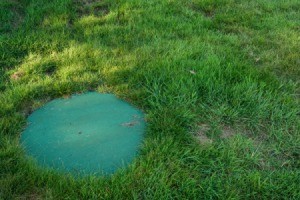 A septic system should effectively accept liquid wastes from your house and prevent biological and nutrient contaminants from getting into your well or nearby lakes and streams. Any time these things do not happen, the system is failing.
A septic system should effectively accept liquid wastes from your house and prevent biological and nutrient contaminants from getting into your well or nearby lakes and streams. Any time these things do not happen, the system is failing.
For example, when waste backs up into your home or liquid is bubbling up in your backyard, the system has obviously failed. If significant amounts of biological or nutrient contaminants reach your well or surface waters, the system is also failing, even though it may appear to be working just fine.
Most septic systems will fail sometime. These systems are designed to have a lifetime of 20 to 30 years, under the best conditions. Eventually, the soil around the absorption field becomes clogged with organic material, making the system unusable.
Many other factors can cause the system to fail well before the end of its "natural" lifetime. Pipes blocked by roots, soils saturated by storm water, crushed tile, improper location, poor original design or poor installation can all lead to major problems.
But by far the most common reason for early failure is improper maintenance by homeowners. When a system is poorly maintained and not pumped out on a regular basis, sludge (solid material) builds up inside the septic tank, then flows into the absorption field, clogging it beyond repair.
Look for these symptoms to determine if you have a serious problem:
The most serious effect of a failing system is the potential for serious disease from the leaking and improperly treated waste. Dysentery and hepatitis can be spread by these wastes. In addition to the diseases themselves, mosquitoes and flies that spread some illnesses can breed in areas where liquid waste reaches the surface.
Chemical or nutrient poisoning can also be a problem. Many of the synthetic products you use around the house, such as strong cleaning products, can be poisonous to humans, pets and wildlife if they travel through soil to your well or on the surface to lakes, streams or ponds. Excess nitrate levels in drinking water can pose serious health threats to infants. The health of plants around your home can be seriously affected, too. The waste from failing systems can kill many species or cause increased growth of undesirable plants.
The economic costs of failure are no less important. The most obvious effect is the direct expense of replacing your septic system. This could cost $2,000 to $4,000. Also consider the indirect cost of losing the use of your house while the system isn't working and the long-term inconvenience of a system that doesn't operate properly.
Follow these steps if you notice any of the symptoms listed above:
In many, if not most, cases, redesigning and replacing the system in a new location is the only practical long term solution. This type of work should be completed only by a qualified contractor. Local health department permits are required before construction can begin. The chemical cures sometimes advertised are ineffective remedies for severely damaged systems.
Other solutions may be of help in some situations, including:
The key to preventing your septic system from failing is proper maintenance. Regularly pumping the tank, being careful in what you put down the drains, and avoiding such things as planting trees over the field or covering the system with permanent patios and home additions are important to keep the system running well.
Proper initial design is another critical aspect in preventing your system from failing. Many septic systems are doomed from the start because they are put in poor locations or constructed improperly. Be sure a new system is installed in an area with proper soil conditions, and at sufficient distances from your house and well (these factors are regulated by local health department codes). Also make sure the system is designed to meet your present and future needs. If, for example, you are building a small home with plans to enlarge it as your family grows, design the septic system to accommodate the largest size you expect your family to grow to. Consider asking your contractor to include such useful features as junction boxes and observation ports, which aid in assessing the condition of the system.
Water conservation was mentioned earlier as a method to keep a marginal system operating, but it is also an excellent method of preventing future problems from occurring.
This information comes from Michigan State University Extension bulletin WQ14, What to Do if Your Septic System Fails.
Source: MSU Extension